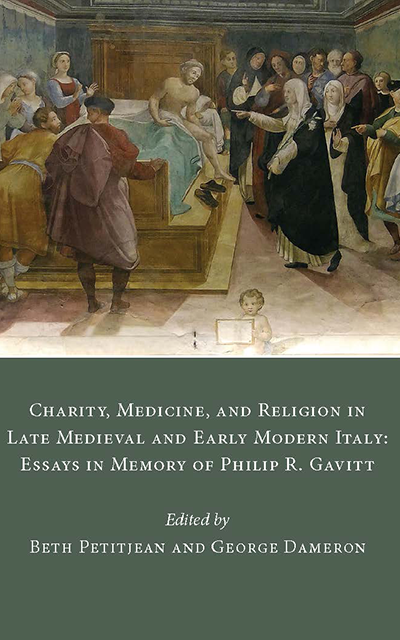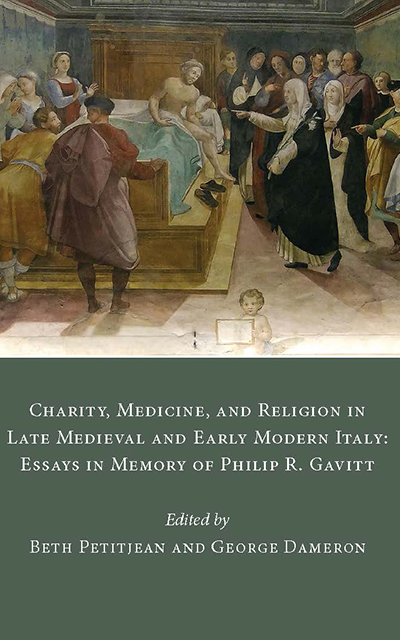Charity, Medicine, and Religion in Late Medieval and Early Modern Italy: Essays in Memory of Philip R. Gavitt
Edited by Beth Petitjean and George Dameron ~ ES58
Description
In the past half century our understanding of late medieval and early modern Italian society, culture, and medicine has significantly progressed into new and surprising directions. One region that has attracted special attention has been Tuscany, unique with rich archives that have yielded fresh insights and perspectives about the lives of pre-modern people. Among the fields of study that have received special attention are those that are highlighted and explored in this collection of essays: charity and the economy, culture and society, family and inheritance, and medicine and health. Interdisciplinary in approach, these eleven essays by leading historians present us with a variety of topics and microhistories that touch on some of the most important aspects of pre-modern Italian life: charity, finance, inheritance, sociability, dowries and family strategies, public perfomance, illness and its cures. Each of these subjects were issues to which the late historian, Philip Gavitt, devoted his professional life. This volume is dedicated to his memory and to the many significant contributions he made to our understanding of the premodern world.
Beth Petitjean is a Digital Learning Specialist with the Reinert Center for Transformative Teaching & Learning at Saint Louis University. Her research focuses on water cures in the early modern world. She has taught history and humanities courses and has published articles on early modern medicine and effective teaching practices.
George Dameron, Professor Emeritus of History at Saint Michael's College, is the author of Episcopal Power and Florentine Society, 1000-1320 (1991) and Florence and Its Church in the Age of Dante (2005) as well as many essays and articles on a wide variety of topics associated with medieval Italy and Europe.
358 pp.
ISBN: 978-0-7727-1079-6
Published: 2024
Contents
Preface
Beth Petitjean
Introduction
George Dameron
Bibliography of Philip R. Gavitt's Works, 1981-2020
Beth Petitjean
Philip Gavitt and the World of Renaissance Italy
1. Nicholas Terpstra - "Philip Gavitt: Exploring the Margins and Tracing the Human"
Charity and Economy
2. William Caferro - "A Public Bank in Trecento Florence?"
3. Daniel Bornstein - "From Farmhouse to House of God: Micro-Institutions of Charity in the Tuscan Countryside"
Culture and Society
4. Konrad Eisenbichler - "The Ambivalent World of Florentine Taverns"
5. Felicia M. Else - "The Sign of the Southern Cross: Borghini's Peru in the Maritime Arch of the 1565 Entrata of Johanna of Austria into Florence"
Family and Inheritance
6. Thomas Kuehn - "Meanings of Family in Inheritance in Renaissance Italy"
7. Dru Swadener - "Daughters, Dowries, and Patrimonies: Social and Financial Strategies of the Tempi Family in Seventeenth-Century Florence"
8. James R. Banker - "Social, Family, and Historical Identity: Piero della Francesca and the Della Francesca Family ="
Medicine and Health
9. Sandra Cavallo - "Habitat, Habit and Changing Ides of Complexion in Early Modern Italy"
10. Paula Findlen - "Becoming A Plague Saint: Catherine of Siena's Healing Miracles"
11. Beth Petitjean - "Patrons of Water: Self-Care and Water Cures at the Medici Court"
Illustrations
Tables
Contributors
Index
Praise
This engaging collection is a window into the society of pre-modern Tuscany. Drawing on the extraordinarily rich Tuscan records, the articles address a range of questions that intersect in revealing ways. Many concern cultures of charity and gender expectations, notably hospitals and convents. Others pursue aspects of these themes, including medical cures, family struggles, and gendered sociability in taverns. The authors include many highly regarded scholars who are also engaging storytellers. The quality of their scholarship and the volume's geographic and thematic focus make it a particularly valuable resource for teaching. — Carol Lansing, University of California Santa Barbara
What is particularly attractive about this impressive collection of essays honouring the memory of Phil Gavitt is that it extends his pathbreaking scholarship with pathbreaking articles that showcase the best of his innovative archive-based scholarship. Scholars and students of the Renaissance will find here not only a fitting tribute to Phil, but also a series of microhistories that display the strengths of archival research as well as the excitement and fascinating perspectives such work offers. — Guido Ruggiero, University of Miami
Couldn't load pickup availability


